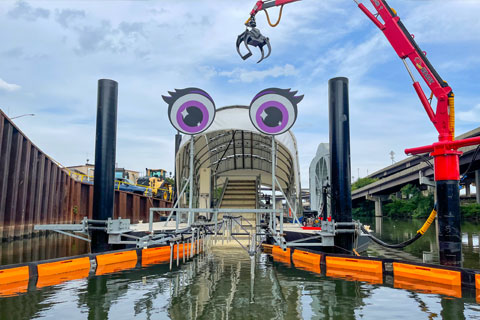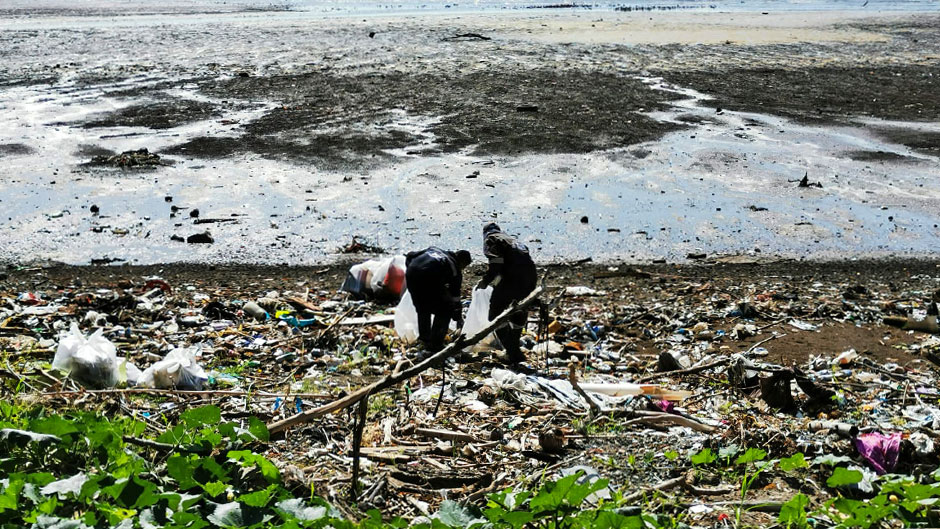Many of the residents who live in the informal settlements near Panama’s Juan Díaz River can recall a tributary so clean that they could swim in it and use its waters for cooking and washing.
But years of neglect in the form of household trash and other debris have turned parts of the river into floating landfills that not only harm the ecosystems of nearby mangroves but also the marine life in Panama Bay—into which the river flows.
Now, an ambitious environmental cleanup project, using a massive solar- and hydro-powered device as a weapon, promises to help restore the Juan Díaz to its former glory.
Doña Rueda, or Ms. Wheel, will be a semiautonomous trash interceptor installed near the mouth of the stream, where it will pull hundreds of tons of trash out of the water each year, protecting critically important ecosystems and ensuring that activities such as fishing and ecotourism can resume.
The permitting phase for the project is nearly completed, and the wheel could be installed as early as August, according to Daniel Suman, a professor of environmental science and policy at the University of Miami Rosenstiel School of Marine and Atmospheric Science, who has been working closely with the Panama City-based environmental group Marea Verde to make the device a reality.
It will be similar to the group of four Mr. Trash Wheel collection devices that have removed 1,600 tons of trash, much of it plastic, from the harbor area of Baltimore, Maryland.

The dome-shaped, moored contraption will have an attached waterwheel powered by the current of the Juan Díaz River. That waterwheel will in turn energize a conveyer belt onto which containment booms will direct trash that will then fall into a dumpster. Solar panels will provide a backup power source when the current is weak. Two, giant googly eyes at the top give the device the appearance of being some sort of living garbage guzzler.
“Today, almost no one uses the water from the Juan Díaz for any purpose whatsoever because it’s so polluted,” Suman explained. “So, this project offers much hope.”
It offers hope specifically to low-income, informal settlements located near the river, where municipal solid waste collection and recycling services are either spotty or nonexistent, leaving some residents with few alternatives but to dump their trash into the Juan Díaz.
For the past year and a half, Suman has conducted community workshops and focus groups via Zoom with many of those residents, documenting their frustrations with how polluted the waterway has become and listening to their wishes for how they’d like to see the river revived.
Last year, COVID-19 prevented some of those online meetings from taking place and pushed back the completion date for the project, as Panama endured a prolonged lockdown and restrictions aimed at stopping the spread of the virus.
“It’s been a great challenge during the pandemic, but despite that, we’ve still been able to conduct a great deal of work virtually,” said Suman, who holds an adjunct appointment at the School of Law.
Most of the residents do not own laptops or desktop computers, Suman noted. So, through outside funding sources, he helped them purchase prepaid phone cards so that they could attend the meetings via their cellphones.
Ana Spalding, an assistant professor of marine and coastal policy at Oregon State University and a University of Miami alumna, partnered with Suman on conducting the focus groups.
What they discovered is that the residents’ biggest fears center on the public health risks posed by pollution in the river. Residents, Suman and Spalding found, also expressed anger at being charged fees for trash collection services that are unreliable. “And surprisingly, they voiced concerns that there are no opportunities for recycling,” Suman said. “The vast majority of them said they would recycle if only there were recycling points located near them.”
As such, in addition to the installation of a trash wheel, the project also calls for a recycling plant and research center to be built near the device, according to Mirei Heras, president of the board of Marea Verde, the organization spearheading the project. “We’ll generate data on how much trash is being prevented from flowing into the river and into Panama Bay,” she said.
Nearly a thousand humpback whales from both the Northern and Southern hemispheres visit Panama Bay each year to nurse their young. Designated a RAMSAR site, or Wetland of International Importance, the bay is also a vital staging site for more than 20 species of migratory shorebirds. But with hundreds of thousands of people living in the Juan Díaz watershed, tons of land-generated trash flows into the bay annually.
“Part of our mission is to educate residents who may not realize that the trash they dump into the river flows into mangroves and the bay and that it is affecting wildlife,” said Sandy Watemberg, project coordinator for Marea Verde.
Yasmina Rojas, who has lived near the Juan Díaz River for almost 25 years and now works for Marea Verde, is looking forward to the day when the trash wheel is finally up and running. “I remember when my mother used to retrieve water from the river to wash our clothes,” Rojas said through an interpreter. “Seeing the river cleaned up would be a dream come true.”

